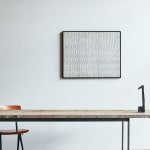Miyawaki Aiko (1929–2014)
3-6-62
Oil and powdered marble on board, framed
Signed by the artist on the back
1962
73 x 91 cm
75 x 93 cm (overall)
Further images
Provenance
Collection of André Schoeller
Without a persistent and lifelong commitment to one’s own ideas, one could hardly call oneself an artist.
Born in Tokyo in 1929, Miyawaki Aiko is a painter and sculptor who is very important as a female artist in postwar Japan. Miyawaki studied under Abe Nobuya and Saito Yoshishige, and after making her debut at Yoseido Gallery in 1959, she went to Milan on the recommendation of Takiguchi Shuzo and others. She spent several years in close contact with local artists such as Lucio Fontana, Enrico Castellani, Piero Manzoni and Man Ray, developing and fine-tuning her own artistic approach, until her temporary return to Japan in 1962. The series of two-dimensional works produced during this period, with their pigments mixed with marble powder that she applied on the canvas not with a brush but a palette knife, can be described as sculptural, and foreshadow Miyawaki’s later shift away from painting and towards sculpture. 3-6-62 (its title probably indicating the date when it was made or completed) features the characteristic, relief-like pattern that the artist achieved by mixing white paint with marble powder, arranged in slightly irregular horizontal rows that cover the whole surface of the canvas. In January 1962, the Parisian art dealer André Schoeller, at that time an influential figure of the French art scene, visited Miyawaki’s solo exhibition at Tokyo Gallery and is said to have acquired fifteen large works for a solo exhibition in Paris. This painting, made in June of that year in Paris, was another of the works in Schoeller’s collection.
In the words of critic Hayashi Michio, there is a persistent tension in Miyawaki’s art between things that are constant and things that are ever-changing. One of the constants in her work was her interest in light, the immaterial phenomenon that changes its appearance in various ways. At the time of her solo exhibition at the Tokyo Gallery, Miyawaki’s friend, the painter Yamaguchi Katsuhiro, suggested to use a slow-moving light to explore its effects on the works. The uneven surface of paint and marble mixture, raising slightly from the surface, indeed allow for a subtle interplay of light and shadow. Depending on the position of the viewer and the light source, the work will appear different, its structure encouraging these sorts of experimentation. There appears a coexistence of softly changing hues of light and the hard surface of the work, a combination that Miyawaki would continue to pursue in its various aspects in her later career.
Miyawaki Aiko (sculptor, painter; 1929–2014)
Sculptor and painter from Tokyo. Miyawaki graduated with a major in history from the Japan Woman’s University and continued to study fine art under Abe Nobuya (painter) and Saito Yoshishige (sculptor and painter) at Bunka Gakuin, Tokyo. She later relocated temporarily to the United States and exhibited widely on an international stage, including in Milan, Paris, and New York. From the 1960s onwards, Miyawaki concentrated on three-dimensional works, making extensive use of materials such as metal and glass.
In the words of critic Hayashi Michio, there is a persistent tension in Miyawaki’s art between things that are constant and things that are ever-changing. One of the constants in her work was her interest in light, the immaterial phenomenon that changes its appearance in various ways. At the time of her solo exhibition at the Tokyo Gallery, Miyawaki’s friend, the painter Yamaguchi Katsuhiro, suggested to use a slow-moving light to explore its effects on the works. The uneven surface of paint and marble mixture, raising slightly from the surface, indeed allow for a subtle interplay of light and shadow. Depending on the position of the viewer and the light source, the work will appear different, its structure encouraging these sorts of experimentation. There appears a coexistence of softly changing hues of light and the hard surface of the work, a combination that Miyawaki would continue to pursue in its various aspects in her later career.
Miyawaki Aiko (sculptor, painter; 1929–2014)
Sculptor and painter from Tokyo. Miyawaki graduated with a major in history from the Japan Woman’s University and continued to study fine art under Abe Nobuya (painter) and Saito Yoshishige (sculptor and painter) at Bunka Gakuin, Tokyo. She later relocated temporarily to the United States and exhibited widely on an international stage, including in Milan, Paris, and New York. From the 1960s onwards, Miyawaki concentrated on three-dimensional works, making extensive use of materials such as metal and glass.





